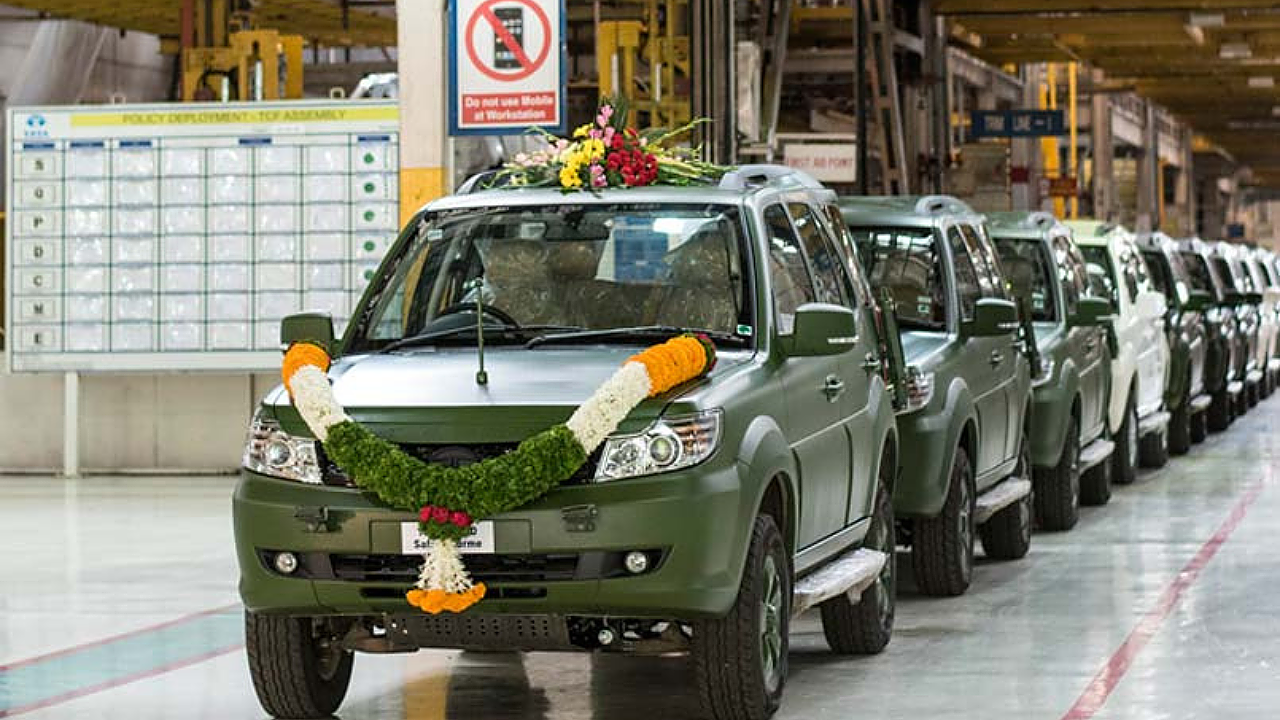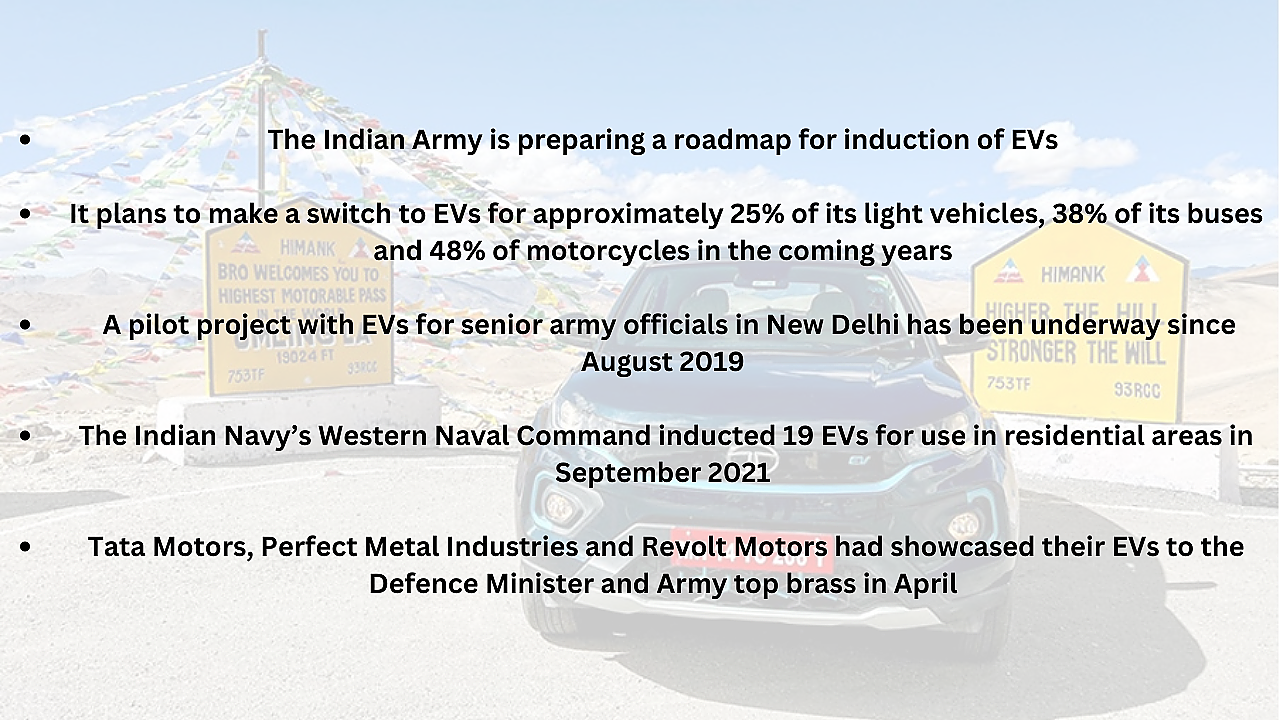
The Indian Army is working on a roadmap for induction of electric vehicles (EV) as part of an effort to reduce its dependence on fossil fuels.
At present, the plans are to use EVs for non-combat purposes at peacetime locations across three categories – cars, buses and motorcycles. Along with the air force, navy and paramilitary forces, the army operates a wide variety of fossil fuel powered vehicles across diverse terrain and weather conditions.
The switch to EVs will be spread for approximately 25% in light vehicles, 38% in buses and 48% in the case of motorcycles. The army has issued an open tender to buy 60 electric buses and 24 fast chargers while setting up EV charging stations at its cantonment areas.
In September last year, the Indian Navy’s Western Naval Command, introduced 19 EVs into service in residential areas at Navy Nagar in South Mumbai. “The induction on such a large scale is a first for the Navy” a spokesperson had said then.
This drive is in line with the Centre’s National Clean Air Programme of 2019 which seeks reduction in the concentration of air particulate matter by 20-30% in 2024. The army top brass is perhaps aware of the benefits of EVs in combat roles thanks to their low noise and thermal signature.
Along with unmanned ground vehicles, they will in all likelihood enter service in the medium term. Ideally, the armed and paramilitary forces will need to adopt a single standard for their EV charging infrastructure to ensure interoperability of these vehicles in a combat theatre.

High Level Buy-In
An EV demonstration was conducted in April in the presence of Rajnath Singh, Defence Minister, and General MM Naravane, the then Army Chief, along with senior officers. Tata Motors, Perfect Metal Industries and Revolt Motors had showcased their EVs at this event and briefed those present on improvements in technology as well as range achieved in the last few years.
General Naravane had said that the army believed that the future was in EVs and wanted to be a torchbearer and lead the way in adopting this technology. A Board of Officers under Lieutenant General Manoj Kumar Singh Yadav, Director General of Supplies & Transport, as presiding officer finalised its recommendations.
It then briefed the Chief of the Army Staff in April about the plans for EVs during the Army Commanders meeting. This Board had been constituted to formulate a definite time-bound roadmap for introducing EVs in the armed forces.
EVs had actually been deployed earlier by the army for its officials in New Delhi in August 2019. This was in partnership with Energy Efficiency Services, a joint Venture of central public sector units under the Ministry of Power. The first lot was flagged off by Lt Gen Gopal R, the then QuarterMaster General.
The army had planned to operate an initial batch of 10 Mahindra e-Veritos in this pilot project before increasing the number for its officials in New Delhi. The greater use of EVs within the armed forces will require significant investment in charging infrastructure. The big incentive will be from The armed forces will also benefit from the Centre’s Faster Adoption and Manufacturing of (Hybrid &) Electric Vehicles in India (FAME I & II) policies.

More importantly, the army’s need for EVs will boost the automotive industry’s order book especially for manufacturers like Tata Motors which has rapidly built up a strong portfolio with electric models such as the Nexon, Tigor and Tiago. Since its entry into the personal EV space in 2020, Tata Motors has sold over 40,000 EVs of which the Nexon accounts for over 30,000 and is the lead player with a 63% market share last fiscal.
In September, a Nexon EV MAX scaled the world’s highest motorable road at the Umling La pass in Ladakh at 19,024 feet above sea level. It was the first electric car to be driven at this altitude.
Tata Motors Defence already has a strong relationship with the armed forces, having supplied over 150,000 vehicles to the Indian military and paramilitary forces since 1958. The Tata Safari Storme 4X4 was selected as the army’s General Service 800 (GS800) vehicle to replace the Maruti Gypsy 4X4 and over 1,500 units have been delivered.
Tata Motors Defence also bagged an army order for supply of 3192 Safari Storme 4X4 vehicles. The indigenously designed Safari Storme GS800 is a contemporary, highly reliable and sturdy diesel SUV with robust features, and a minimum payload capacity of 800 kg. It can seat six passengers and offers 60% higher payload, over 70% higher power and over 200% higher torque as compared to the 1980s era Maruti Gypsy 4X4.
Tata Motors undertook extensive trials with the army for 15 months in varied terrain and has been customised to endure severely rugged operational conditions ranging from high-altitude drives and traversing snowbound regions, crossing deserts to marshy lands. The Tata GS800 Safari Storme 4X4 was specially customised for the army with recovery hooks, jerry can and fog lamps.
Also Read
“We See Huge Opportunities In Aerospace Led By defence, Design-led Manufacturing, Digital”